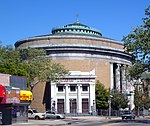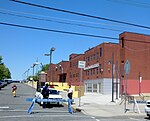Temple B'Nai Abraham

Temple B'nai Abraham is a synagogue in Livingston, New Jersey. It was established in Newark in 1853. Its historic 1924 building at 621 Clinton Avenue in was designed by Newark architect Nathan Myers, who later designed the iconic Hersch Tower in Elizabeth, New Jersey . In 1973, the congregation moved to Livingston and sold the building to the Deliverance Evangelistic Center, a Pentecostal Church. It was added to the National Register of Historic Places in 2007. Dr. Joachim Prinz, the rabbi from 1939 to 1976, modernized the ritual and introduced his own prayer book. Dr. Prinz, who had escaped Nazi Germany in 1937, became a vocal civil rights leader in the United States, known globally for his moving rhetoric. His successor, Rabbi Barry Friedman introduced further innovations in the services and wrote and edited the prayer book Siddur Or Chadash. In 1999, Rabbi Clifford Kulwin became the synagogue's fourth religious leader in 98 years. Rabbi David Z. Vaisberg became the next senior rabbi in 2019. For much of the 20th Century, Temple B'nai Abraham identified itself as a traditional progressive congregation, independent of the organized synagogue movements.
Excerpt from the Wikipedia article Temple B'Nai Abraham (License: CC BY-SA 3.0, Authors, Images).Temple B'Nai Abraham
Clinton Avenue, Newark
Geographical coordinates (GPS) Address External links Nearby Places Show on map
Geographical coordinates (GPS)
| Latitude | Longitude |
|---|---|
| N 40.723055555556 ° | E -74.206944444444 ° |
Address
Deliverance Temple
Clinton Avenue 621
07108 Newark
New Jersey, United States
Open on Google Maps



